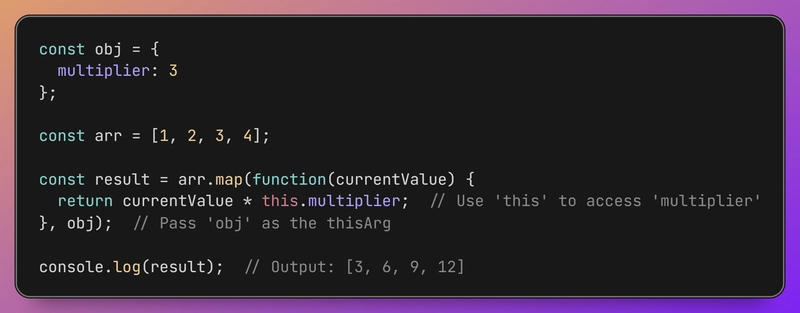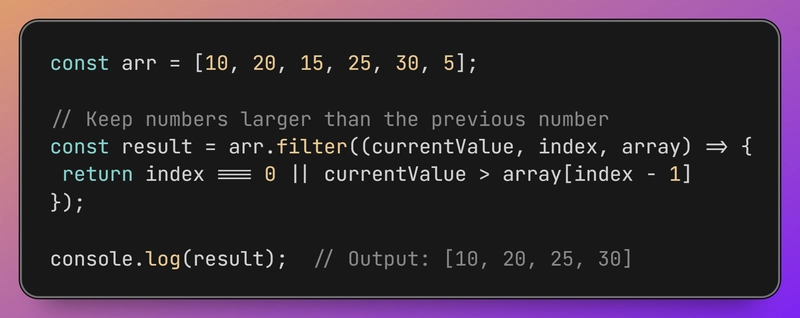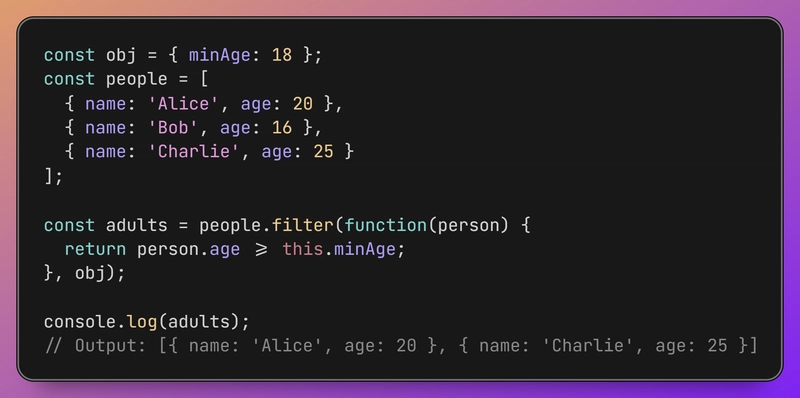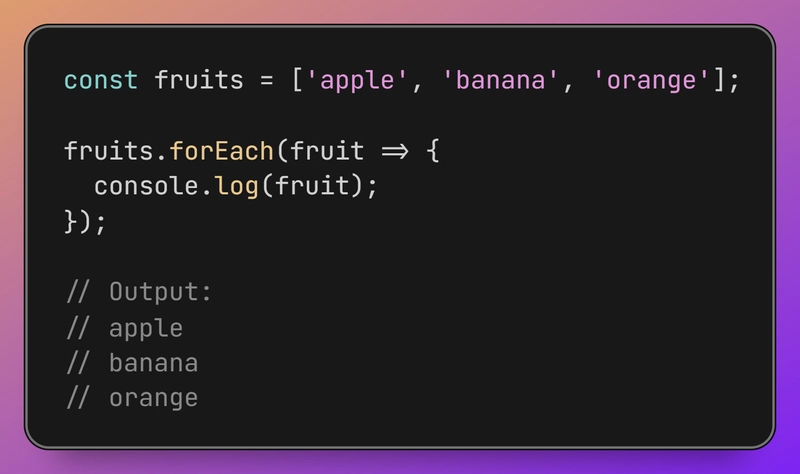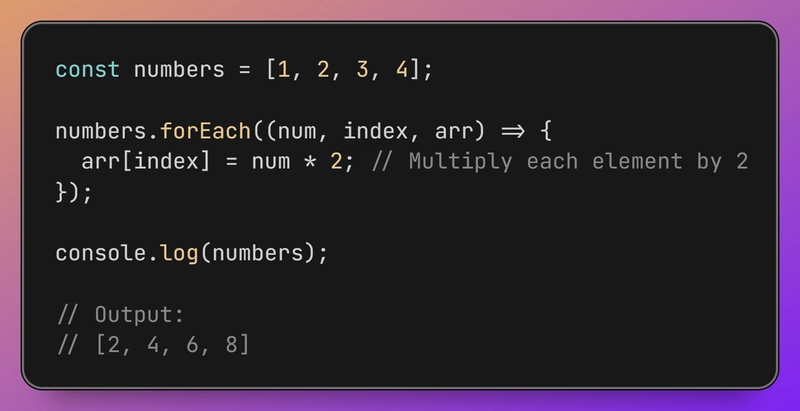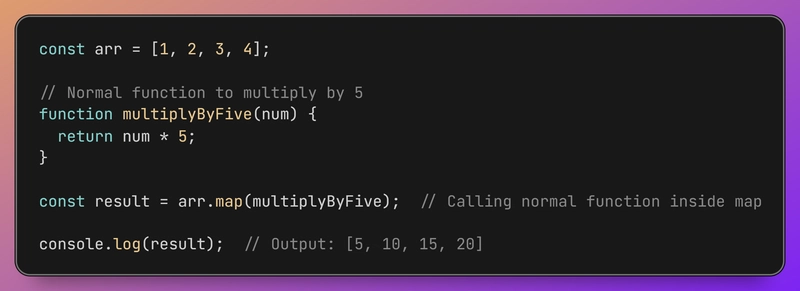From Beginner to Pro: The Ultimate Guide to map(), filter(), reduce(), and forEach()
map(), filter(), reduce() and forEach() are the most commonly used Array methods in JavaScript. Let’s dive deeper and learn about these methods. 1. map() Method: Transforming Arrays map() is a higher-order function used to iterate over each element in the array and return a new array of the same length, with each element transformed by the provided callback. Syntax: callback is the function to be executed on each element of the array. currentValue - The current element being processed in the array. index - index of the current element. (optional) array - The original array on which map() was called. The index of the current element being processed in the array. (optional) thisArg is an optional parameter, which allows you to specify the value of this inside the callback function. Let see a simple example how map() will work with each params Basic Example: Multiply each element by 2 index: The index of the current element in the array array: The original array on which map() is called thisArg: A value to use as this when executing the callback function 2. filter() Method: Selecting Elements Based on a Condition The filter() method allows you to create a new array containing only those elements that pass a certain test. Unlike map(), which transforms each element, filter() filters out elements that don't meet the criteria. Syntax: callback- The function to test each element. currentValue - The current element being processed in the array. index - index of the current element. (optional) array - The original array on which map() was called. The index of the current element being processed in the array. (optional) thisArg is an optional parameter, which allows you to specify the value of this inside the callback function. Basic Example: Filtering Even Numbers Using the index and array Parameters Using thisArg for Contextual Filtering 3. reduce() Method: Accumulating Values The reduce() method allows you to accumulate a single result from all elements of an array by applying a function that you provide. It's typically used for summing values, but you can also use it for other purposes like flattening an array, combining objects, etc. Syntax: callback(accumulator, currentValue, index, array): The callback function is executed on each element of the array. It takes four parameters: accumulator: The value that keeps track of the result as we go through each item in the array. It gets updated during each iteration based on the operation you want to perform. currentValue: The current element being processed in the array. index: The index of the current element (optional). array: The original array that reduce() was called on (optional). initialValue: The initial value to start accumulating (optional). If omitted, the first element of the array is used, and the iteration starts from the second element. Basic Example: Summing Numbers Basic Example: Flattening an Array Using the index and array Parameters 4. forEach() Method: Iterating Over Arrays The forEach() method is used to execute a provided function on every element in the array. It’s the most basic way to loop through arrays in JavaScript but differs from map() and filter() in that it doesn’t return a new array. Instead, it simply performs the operation for each item without accumulating or transforming the array. Syntax: callback - The function to execute on each element in the array. currentValue - The current element being processed in the array. index - The index of the current element being processed in the array. array - The original array on which forEach() was called. thisArg - An optional argument that specifies the value of this inside the callback function. Basic example Using the index and array Parameters Using thisArg Bonus Tip: Using Normal Functions and Calling External Functions Although we've used arrow functions extensively, you can also use normal functions and call external functions inside methods like map(), filter(), reduce(), and forEach() Using a Normal Function Inside map() Calling an External Function Inside map() These techniques are not limited to map(); they can be applied similarly to filter(), reduce(), and forEach(). Using normal functions and external functions can make your code more modular and easier to read, especially when dealing with complex operations or reusable logic. Conclusion: In this article, we've explored four of the most commonly used array methods in JavaScript: map(), filter(), reduce(), and forEach(). These methods allow for clean, functional-style iterations over arrays, making your code more readable and expressive. map() allows you to transform each element in an array and return a new array with the same length but modified values. filter() helps you select elements from an array based on a condit

map(), filter(), reduce() and forEach() are the most commonly used Array methods in JavaScript. Let’s dive deeper and learn about these methods.
1. map() Method: Transforming Arrays
map() is a higher-order function used to iterate over each element in the array and return a new array of the same length, with each element transformed by the provided callback.
-
callbackis the function to be executed on each element of the array.-
currentValue- The current element being processed in the array. -
index- index of the current element. (optional) -
array- The original array on whichmap()was called. The index of the current element being processed in the array. (optional)
-
-
thisArgis an optional parameter, which allows you to specify the value ofthisinside the callback function.
Let see a simple example how map() will work with each params
Basic Example: Multiply each element by 2
-
index: The index of the current element in the array
-
array: The original array on which map() is called
-
thisArg: A value to use as this when executing the callback function
2. filter() Method: Selecting Elements Based on a Condition
The filter() method allows you to create a new array containing only those elements that pass a certain test. Unlike map(), which transforms each element, filter() filters out elements that don't meet the criteria.
-
callback- The function to test each element.-
currentValue- The current element being processed in the array. -
index- index of the current element. (optional) -
array- The original array on whichmap()was called. The index of the current element being processed in the array. (optional)
-
-
thisArgis an optional parameter, which allows you to specify the value ofthisinside the callback function.
Basic Example: Filtering Even Numbers
- Using the
indexandarrayParameters
- Using
thisArgfor Contextual Filtering
3. reduce() Method: Accumulating Values
The reduce() method allows you to accumulate a single result from all elements of an array by applying a function that you provide. It's typically used for summing values, but you can also use it for other purposes like flattening an array, combining objects, etc.
-
callback(accumulator, currentValue, index, array): The callback function is executed on each element of the array. It takes four parameters:-
accumulator: The value that keeps track of the result as we go through each item in the array. It gets updated during each iteration based on the operation you want to perform. -
currentValue: The current element being processed in the array. -
index: The index of the current element (optional). -
array: The original array that reduce() was called on (optional).
-
-
initialValue: The initial value to start accumulating (optional). If omitted, the first element of the array is used, and the iteration starts from the second element.
Basic Example: Summing Numbers
Basic Example: Flattening an Array
- Using the
indexandarrayParameters
4. forEach() Method: Iterating Over Arrays
The forEach() method is used to execute a provided function on every element in the array. It’s the most basic way to loop through arrays in JavaScript but differs from map() and filter() in that it doesn’t return a new array. Instead, it simply performs the operation for each item without accumulating or transforming the array.
-
callback- The function to execute on each element in the array.-
currentValue- The current element being processed in the array. -
index- The index of the current element being processed in the array. -
array- The original array on whichforEach()was called.
-
-
thisArg- An optional argument that specifies the value of this inside the callback function.
Basic example
- Using the
indexandarrayParameters
- Using
thisArg
Bonus Tip: Using Normal Functions and Calling External Functions
Although we've used arrow functions extensively, you can also use normal functions and call external functions inside methods like map(), filter(), reduce(), and forEach()
These techniques are not limited to map(); they can be applied similarly to filter(), reduce(), and forEach(). Using normal functions and external functions can make your code more modular and easier to read, especially when dealing with complex operations or reusable logic.
Conclusion:
In this article, we've explored four of the most commonly used array methods in JavaScript: map(), filter(), reduce(), and forEach(). These methods allow for clean, functional-style iterations over arrays, making your code more readable and expressive.
-
map()allows you to transform each element in an array and return a new array with the same length but modified values. -
filter()helps you select elements from an array based on a condition, creating a new array of only the matching elements. -
reduce()gives you the ability to accumulate values across the array, making it perfect for summing, averaging, or combining data in more complex ways. -
forEach()simply iterates over an array and executes a function for each element, with optional access to the index and the entire array.
By understanding and effectively using these methods, you'll be able to handle array manipulations more efficiently and write more declarative and concise code. While these methods are powerful individually, they can also be combined to achieve more sophisticated operations on arrays.
So next time you're faced with an array operation, consider using one of these methods. With practice, you'll find that your JavaScript code becomes cleaner, more readable, and easier to maintain.
This is my first blog, and I appreciate your understanding. Feel free to share any feedback or suggestions—I’m always eager to learn and improve!







































































